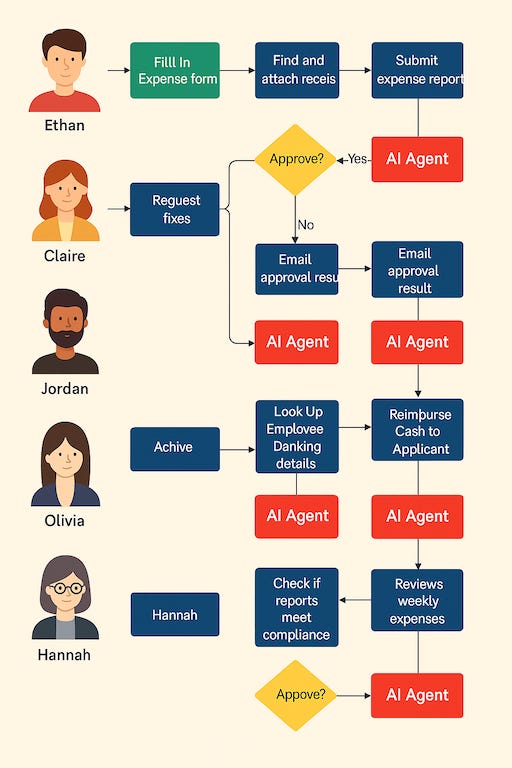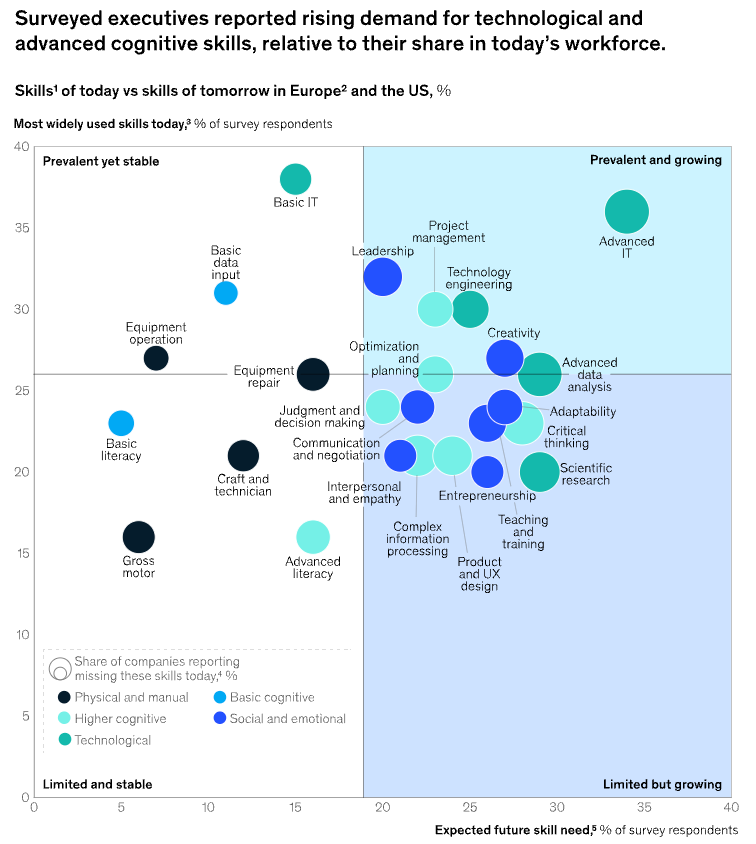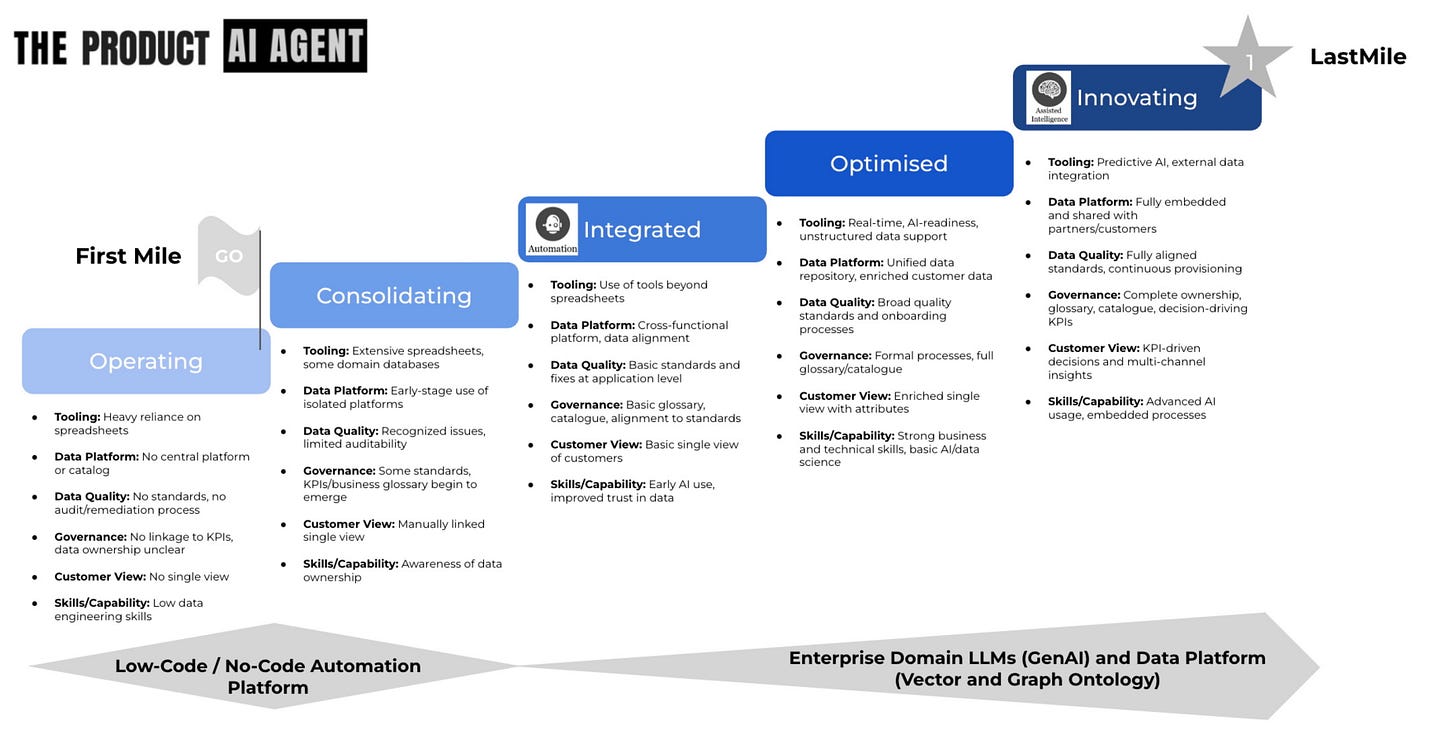The low-code automation trap. Why product managers practicing enterprise AI Agent skills see 35-60% salary increase
How automating with Low-code/No-code solutions decreases your likelihood of faster leadership advancement.
Your n8n workflows have impressed everyone.
Your automation demos get positive reactions.
You're working on high-profile AI projects that feel strategically important.
Six months later, you're still in the same role whilst colleagues who focused on Enterprise AI frameworks are commanding 35-60% salary premiums and getting fast-tracked to leadership positions.
If this sounds familiar, you've fallen into what I call the ‘Automation Thinking Trap’.
It’s one of three career-limiting beliefs that keep talented people stuck in tactical roles building the shiny toy as the outcome, instead of Enterprise AI, where they can advance rapidly through the ranks:
Career-limited belief 1 - Working on AI projects provides job security
Career-limited belief 2 - Automation tools develop transferable AI skills
Career-limited belief 3 - AI project success proves PM strategic thinking
Let’s examine the patterns that distinguish successful AI PM careers from stagnant ones.
COMING END JULY 2025!
If you want to ‘Master Agentic AI product and design’ before your competition…..
……enjoy a 50% discount on the ‘No Spoon Survival Guide’.
The Kosi Pierre-Louis reality check: When AI automation work offers no career protection
Marcus Nkosi Pierre-Louis epitomises why tactical AI work isn't enough for career security. At 25, this Duke Computer Science graduate was thriving as a Product Manager on Microsoft Security Copilot, working on what many considered the company's most strategic AI initiative.
On 13th May 2025, he was laid off alongside 6,000 colleagues, despite being labelled a "high performer."
Pierre-Louis fell into all three career-limiting beliefs simultaneously before that fateful day:
He believed working on AI projects provided job security (working gruelling hours, mostly international meetings)
He focused on automation capabilities rather than strategic frameworks (shipping impressive AI features instead of business value systems)
He assumed technical AI skills were sufficient (without developing the executive communication and strategic positioning abilities that create career indispensability)
The devastating irony?
Microsoft's rationale was brutally clear:
“AI tools now write 20-30% of their code, enabling flatter team structures with fewer middle managers."
The automation-focused PMs helped build the very systems that eliminated their roles.

Meanwhile, Gabriela de Queiroz, Microsoft's Director of Artificial Intelligence with 18 years at the company, was also eliminated in the same round. Even senior AI leadership roles offer no protection when they're positioned tactically rather than strategically.
Industry expert validation: The Enterprise AI Reality
Recent industry discussions reveal the depth of complexity that separates real enterprise AI from automation workflows.
As Mani Gil from Boomi explains:
"AI is the tip of the spear and data the wood behind that arrow."
Despite the hype, most enterprises are far from ready to unlock the value of truly autonomous AI. The overwhelming majority are still treating AI as a subscription. They pay for ChatGPT or Copilot, configure some automations, and call it transformation.
The stats are striking:
Eighty per cent of organisations are using paid GenAI tools (such as ChatGPT and Copilot) as plug-and-play productivity boosters.
Only 27% are building their proprietary LLMs.
Just 39% are using open-source models on their infrastructure.
Most product managers are being asked to configure, experiment with, and automate at the edge, rather than architecting the robust, integrated foundations that true agentic AI requires.
Enterprise PMs, on the other hand, are apply a strategic lens. They learn how to bridge this readiness gap, moving beyond demos and workflows to shape the long-term infrastructure and governance that makes AI a true enterprise capability.
The trend is now becoming a realisation for most companies, as seen in this YouTube video from Dataiku. Whilst I don’t agree with all the points around the ROI and how an agentic AI system works, the Enterprise mindset of ‘agentic AI’ is now a discussion point.
Why strategic AI thinking wins careers
Industry evidence is now overwhelming. The gap isn’t between PMs who can use AI and those who can’t. It’s between those who can architect a path through the complexity.
This includes, across data, integration, and governance, as well as those who can’t.
The career impact is clear:
PMs operating tactically: using AI to automate tasks or build simple features, are becoming commoditised.
Those who think strategically: Driving platform infrastructure, integration, and governance command significant salary premiums and are being fast-tracked for leadership.
What sets strategic thinkers apart is their ability to address the real barriers holding back the adoption of agentic AI, the ones that most teams ignore until it’s too late.
These gaps trap most PMs. They are not just technical hurdles; they are the foundation of any sustainable AI solution and include the following:
Data Quality & Lineage: Most organisations are mired in siloed, inconsistent, and unreliable data. Without a single, high-integrity source of truth, agentic AI can’t operate safely or at scale, period.
Integration & Orchestration: Too many AI pilots remain isolated from the business. The real challenge, and the strategic opportunity, is rethinking how AI will impact the whole enterprise stack, i.e., bridging legacy systems with new embedded intelligence where workflow data lives.
Governance & Trust: Regardless of how advanced the model, executives won’t green-light AI for high-impact roles without robust governance. That means clear accountability, audit trails, and transparent decision logic.
Strategic PMs understand that solving these issues isn’t just about IT hygiene; it’s the lever for unlocking business-wide transformation and making themselves indispensable in the process.
The three Career-Limiting beliefs trapping automation-cocused PMs
Before we get into solutions, it’s worth asking:
“Why do so many talented product managers end up stuck in tactical roles, even when they’re working hard and building impressive AI features?”
The answer lies in a set of career-limiting beliefs that are surprisingly common, and quietly destructive. These beliefs are subtle traps, reinforced by company culture, peer pressure, and the sheer pace of AI hype.
Left unchecked, they keep PMs boxed in as implementers, not leaders. If any of the following sound familiar, it’s time for a reality check:
Career-Limiting Belief #1: "Working on AI projects provides job security"
Why does this belief form?
You're working on cutting-edge technology that feels strategically important. Your demos impress stakeholders. Leadership talks about AI transformation as a company priority.
The Career reality:
Microsoft eliminated 817 software engineers, alongside more than 600 product managers, despite making record investments in AI. Amazon cut 700 employees from its Alexa division as it pivoted to generative AI. Google laid off over 200 Core team members while increasing funding for Bard and Gemini.
The Data Infrastructure gap:
Automation-focused PMs miss the enterprise complexity that creates strategic value. They see AI projects as feature development rather than infrastructure transformation. Meanwhile, strategic PMs understand that real enterprise AI requires data product expertise.
The Strategic insight:
After debugging multiple enterprise AI initiatives, I've observed that working on AI technology doesn't guarantee career security; becoming indispensable to an AI business strategy does.
The PMs who survive layoffs are those who understand why Microsoft Security Copilot required enterprise data orchestration across multiple security systems, not just those who built the chat interface.
They're the ones executives turn to when asking:
"How do we architect AI infrastructure for regulatory compliance?" not "Can you build this AI feature?"
Strategic PMs position themselves as infrastructure advisors who understand the $50M+ data engineering investments required for enterprise AI deployment.
Career-Limiting Belief #2: "Automation tools like n8n develop transferable AI skills"
Why does this Belief form?
No-code automation tools feel like a practical way to develop AI skills. You're solving real problems, creating workflows, and building capabilities that demonstrate value.
The Career reality:
Despite 100s of job postings mentioning no-code experience, these roles typically hit career ceilings at mid-level positions. 75% of employers struggling to find qualified AI PM candidates are specifically seeking strategic AI expertise, not proficiency in automation tools.

The Data Infrastructure gap:
Automation tools mask the enterprise complexity that creates career value. While automation-focused PMs learn drag-and-drop workflows, strategic PMs understand enterprise requirements that no-code tools cannot address:
CDC (Change Data Capture) engines for real-time data streaming vs. batch processing limitations
Vector databases for agent memory and knowledge storage vs. simple data tables
Enterprise observability for tracking AI Agent decision paths vs. basic workflow monitoring
Data lineage systems for regulatory compliance vs. simple audit logs
Distributed architecture for scaling to millions of users vs. single-node limitations
The Strategic Insight:
Having shipped multiple AI products from POC to production scale, I've learned that automation tools are stepping stones to find pivot, not destinations. They create fundamental limitations:
Scalability issues: Can't handle enterprise complexity or custom requirements
Security vulnerabilities: Enterprise environments require governance frameworks that no-code tools can't provide
Strategic shallow-ness: Focus on operational efficiency rather than competitive advantage creation
As Jason Proto from RSM explains:
"Enterprise pricing still imposes workflow limits for 'absurd amounts of money'... Tool calling 'doesn't work 100% of the time' - a fundamental failure for production systems."
Strategic PMs understand why enterprises spend $500K+ on data infrastructure platforms rather than $99/month automation tools.
Career-Limiting Belief #3: "AI project success proves PM strategic thinking"
Why does this Belief form?
Your AI initiatives work well technically. User feedback is positive. You're delivering on commitments and hitting milestones.
The Career reality:
70-85% of AI projects fail despite impressive technical execution. McKinsey shows only 1% of executives describe their generative AI rollouts as "mature". The 30% that are abandoned after proof of concept aren't failing due to poor engineering—they're failing due to strategic positioning gaps.
The Data Infrastructure gap:
Technical project success without an understanding of infrastructure strategy creates career limitations. Automation-focused PMs celebrate working demos while missing the enterprise complexity that determines scalability.
For example, I think about the following when problem-solving with technical and business teams:
Proof-of-concepts that work with 100 users but fail with 100,000 due to data pipeline limitations.
Demo environments that bypass enterprise security, governance, and compliance requirements.
Feature implementations that ignore data lineage, observability, and audit requirements.
Tactical solutions that create technical debt rather than strategic infrastructure assets.
The Strategic insight
After facilitating dozens of executive AI strategy sessions, I've observed that technical success does not necessarily translate to career advancement, and it is essential to articulate the strategic business impact in executive language.
Strategic PMs understand why a "successful" AI feature might require $5M in data infrastructure investment to reach production scale—and they position this complexity as business value rather than technical debt.
What do you think? Tried these approaches?
Your Career Transformation Roadmap
If you're currently focused on automation tools and tactical AI work, here's your systematic transition to change that thinking and head towards strategic AI product management:
Month 1: Foundation Assessment
Audit your current AI experience against strategic versus tactical positioning.
Identify gaps in executive communication and business framework development.
Begin transitioning from tool-focused to strategy-focused learning
Assess technical infrastructure knowledge using industry frameworks
Month 2: Strategic Skill Development
Learn value-case workshop facilitation to align stakeholders around AI business outcomes.
Develop benefit-case scoring models that demonstrate disciplined AI investment thinking.
Practice translating technical AI capabilities into executive-friendly business language.
Study enterprise architecture patterns for AI deployment.
Month 3: Executive Network Building
Seek opportunities to present AI business cases to senior stakeholders.
Volunteer for cross-functional AI initiatives that require strategic coordination.
Begin positioning yourself as the person executives turn to for expert advice on AI strategy.
Attend industry events focused on AI business strategy (not just technical implementation).
Month 4: Career Market Positioning
Update your professional profile to emphasise strategic AI expertise over tool proficiency.
Seek roles that require AI business strategy rather than just AI implementation.
Network with executives who are making AI investment decisions.
Document strategic outcomes from your AI initiatives, not just technical achievements.

Your Next Steps: From Automation Trap to Strategic Leadership
The data is clear. Product managers who develop strategic AI business expertise significantly outperform their automation-focused peers in terms of career advancement, compensation, and long-term job security.
The path forward requires abandoning tactical automation mindsets for strategic AI business frameworks that create value rather than eliminate it.
Next steps:
Assess your current positioning using the Career Transformation Tracker strategic framework.
Identify one enterprise AI infrastructure challenge in your organisation and apply the transformation.
Schedule meetings with executives to discuss AI investment priorities.
Begin documenting strategic business impact, not just technical achievements.
Join strategic AI communities and distance yourself from automation-focused groups.
If you want to join the PMs earning 35-60% salary premiums and advancing 2-3 years faster to leadership positions, start building the executive-level AI business expertise that makes you indispensable to strategic decision-making.
Automation tools will always be available. The strategic positioning window is closing fast.
🙋♂️ Are you stuck in automation tactical decisions or shifting towards strategic AI thinking? Drop your views in the comments. Let's compare notes.
🔁 Share with a designer or PM still treating agents like chatbots.





